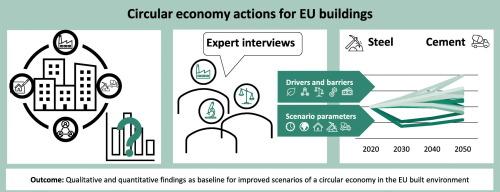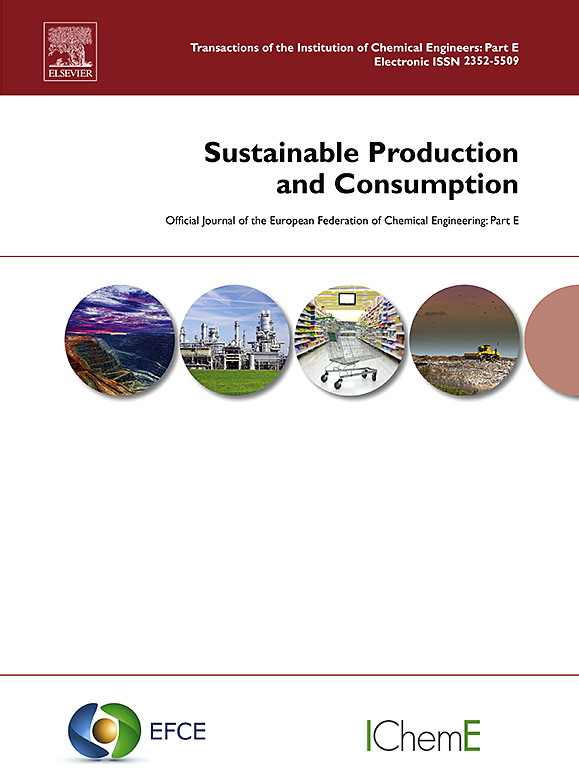估算欧盟建筑循环经济行动对基本材料需求的影响范围:定性与定量相结合的方法
IF 10.9
1区 环境科学与生态学
Q1 ENVIRONMENTAL STUDIES
引用次数: 0
摘要
建筑循环经济有助于减少对排放密集型基础材料的需求,从而实现欧盟的气候目标。然而,由于未来的不可预测性,量化对材料需求的影响面临挑战。我们将定性和定量方法相结合,以加深对未来发展的理解。具体而言,我们对专家进行了访谈,以确定影响因素,并收集用于模拟未来材料需求的估计值。结果表明,现有的和新的政策、气候变化以及人口统计因素都推动了适应性的发展。与此形成鲜明对比的是各种障碍,如经济上的不可行性、替代品的有限可用性、供需不匹配以及建筑法规。此外,影响因素的类型也反映了与循环经济相关的各项战略的成熟度。与参考发展相比,循环经济行动对 2050 年建筑材料年需求量的影响估计介于 -42 % 和 +25 % 之间。然而,不仅各个行动之间存在差异,各个行动内部也存在差异。简而言之,循环经济行动的成熟度体现在对材料需求的影响范围上。定性影响因素和定量建模结果的新颖结合揭示了驱动因素和障碍与对材料需求的影响之间的相互关系。这突出表明,可以通过调整政策框架条件来积极影响这些潜力的开发前景。这一点对于知名度较低的循环经济战略和行动尤为重要,这些战略和行动的特点是高潜力和高不可预测性。本文介绍的结果为更系统地考虑欧盟建筑未来方案中与循环经济相关的材料削减潜力奠定了基础。本文章由计算机程序翻译,如有差异,请以英文原文为准。

Estimating the impact range of circular economy actions for buildings on basic material demand in the European Union: A combination of qualitative and quantitative approaches
A circular economy in buildings can contribute to reduce the demand for emission-intensive basic materials and thus, to achieve the climate targets of the European Union. However, quantifying the impact on material demand is challenged by the unpredictability of the future. We combined qualitative and quantitative approaches to improve the understanding of such future developments. In detail, expert interviews were conducted to identify influencing factors and to collect estimates for modelling prospective material demand. The results indicate that the adaption is driven by existing and new policies, climate change as well as demographics. This is contrasted by barriers, such as the economic non-viability, the limited availability of substitutes, and the mismatch of supply and demand as well as building regulations. Moreover, the type of influencing factor reflects the maturity of individual strategies related to a circular economy. The estimated impact of circular economy actions on annual material demand for buildings varies between −42 % and +25 % in 2050 compared to a reference development. However, there are not only differences between but also within individual actions. In brief, the maturity of the circular economy actions is reflected by the range of impact on material demand. The novel combination of the qualitative influencing factors and the quantitative modelling results reveals an interrelationship between the drivers and barriers and the impact on material demand. This underlines that the prospective exploitation of these potentials can be actively influenced by adapting the policy framework conditions. This is particularly relevant for less renowned circular economy strategies and actions that are characterized by high potential and high unpredictability. The presented results lay the foundation for a more systematic consideration of material reduction potentials related to a circular economy in prospective scenarios of buildings in the European Union.
求助全文
通过发布文献求助,成功后即可免费获取论文全文。
去求助
来源期刊

Sustainable Production and Consumption
Environmental Science-Environmental Engineering
CiteScore
17.40
自引率
7.40%
发文量
389
审稿时长
13 days
期刊介绍:
Sustainable production and consumption refers to the production and utilization of goods and services in a way that benefits society, is economically viable, and has minimal environmental impact throughout its entire lifespan. Our journal is dedicated to publishing top-notch interdisciplinary research and practical studies in this emerging field. We take a distinctive approach by examining the interplay between technology, consumption patterns, and policy to identify sustainable solutions for both production and consumption systems.
 求助内容:
求助内容: 应助结果提醒方式:
应助结果提醒方式:


